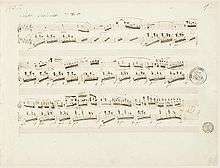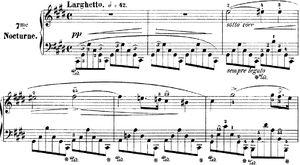Nocturnes, Op. 27 (Chopin)

The Nocturnes, Op. 27 are two solo piano pieces composed by Frédéric Chopin. The pieces were composed in 1836[1] and published in 1837. Both nocturnes in this opus are dedicated to Countess d'Appony.
This publication marked the transition from triplets of nocturnes to contrasting pairs.[2]
David Dubal feels that the pieces are "more aptly described as ballades in miniature".[3] Blair Johnson states that these two nocturnes are "two of the most powerful—and famous—nocturnes [Chopin] has ever penned" and that these nocturnes are "virtually unrecognizable" to those of John Field.[4]
Nocturne in C-sharp minor, Op. 27, No. 1

The Nocturne in C-sharp minor is initially marked larghetto and is in 4/4 meter. It transitions to più mosso (more movement) in measure 29. The piece returns to its original tempo in measure 84, and ends in an adagio beginning in measure 99. The piece is 101 measures long and written in ternary form with coda; the primary theme is introduced, followed by a secondary theme and a repetition of the first.
The opening alternates between major and minor and uses arpeggios, commonly found in other nocturnes as well, in the left-hand. It sounds "morbid and intentionally grating".[4] James Friskin noted that the piece requires an "unusually wide extension of the left hand" in the beginning and called the piece "fine and tragic".[5] James Huneker commented that the piece is "a masterpiece",[6] pointing to the "morbid, persistent melody" of the left hand.[6] For David Dubal, the più mosso has a "restless, vehement power".[7] Huneker also likens the più mosso to a work by Beethoven due to the agitated nature of this section.[6] The coda "reminds the listener of Chopin's seemingly inexhaustible prodigality" according to Dubal[7] while Huneker calls it a "surprising climax followed by sunshine" before returning to the opening theme.[6]
In theatre
The first duet of the ballet In the Night by Jerome Robbins (1970) was choreographed to this music.
Excerpts
 The second theme of No. 1 in C♯ minor
The second theme of No. 1 in C♯ minor Modulation to A♭ major
Modulation to A♭ major
Nocturne in D-flat major, Op. 27, No. 2

The Nocturne in D-flat major is initially marked as lento sostenuto and is in 6/8 meter. It consists of two strophes, repeated in increasingly complex variations. The piece is 77 measures long.

Blair Johnston calls the main cadence, near the end of the piece, "one of the most glorious moments in Chopin's entire output".[4] Johnston also calls the piece "one of [Chopin's] most graceful essays in fioritura ornamental practices".[4] Huneker states that the piece "really contains but one subject, and is a song of the sweet summer of two souls, for there is obviously meaning in the duality of voices."[8] He also claims that the piece is "harmonically most interesting".[8] Friskin states that the piece contains "broken rhythms and slurs which require a delicate hand touch".[5]
The piece occasionally has been featured in popular culture, such as in the 1977 film The Spy Who Loved Me,[4][9] the 1998 Russian film The Barber of Siberia, and the webcomic Saturday Morning Breakfast Cereal.[10]
References
- ↑ Huneker, James G. (1966). Chopin : the man and his music. New York: Dover Publ. p. 251. ISBN 0-486-21687-X.
- ↑ Samson, Jim (2009). "Nocturne in D flat major, Op 27 No 2". Hyperion Records. Retrieved 2009-10-07.
- ↑ Dubal, David (2004). The art of the piano : its performers, literature, and recordings. Pompton Plains, N.J.: Amadeus Press. p. 461. ISBN 1-57467-088-3.
- 1 2 3 4 5 Woodstra, Chris; Brennan, Gerald; Schrott, Allen (2005). AllMusic Guide to Classical Music. Hal Leonard Corporation. p. 287. ISBN 0-87930-865-6. Retrieved 21 March 2009.
- 1 2 Friskin, James; Irwin Freundlich (1973). Music for the piano; a handbook of concert and teaching material from 1580 to 1952. New York: Dover Publications. p. 106. ISBN 0-486-22918-1.
- 1 2 3 4 Huneker (1966), p. 259
- 1 2 Dubal (2004), p. 463
- 1 2 Huneker (1966), p. 260
- ↑ "Trivia - The Spy Who Loved Me". James Bond Museum. Retrieved 2009-03-30.
- ↑ Saturday Morning Breakfast Cereal, n. 2454
External links
- Nocturnes, Op. 27: Scores at the International Music Score Library Project (IMSLP)